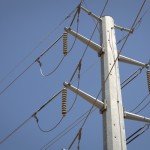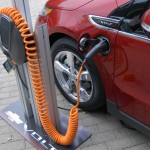Will Electric Cars Strain the Texas Grid?
Electric vehicles, whether they be plug-in hybrids like the Chevy Volt, or completely electric, combustion-free cars like the Nissan Leaf, are often heralded for their low emissions and high mileage.
While these plug-in vehicles have seen lower-than-projected sales since their debut in late 2010, there’s the possibility that we’re still in the “early adopter” phase. As oil prices go up (and plug-in car prices come down) we’ll likely see more and more of them on the road and at the charging station.
Which is a cause for concern. All of those cars have to charge their batteries somewhere, and that means more energy demand on an already-strained electric grid in Texas. More energy could come from coal or gas power plants, which means though the cars are emitting less, they are still relying on fossil fuel energy to run (and causing emissions in the process).
How can the grid deal with this? Karl Rábago, the Vice President for Distributed Energy Services at Austin Energy, addressed the issue yesterday at the 2012 Wind, Solar and Storage conference at the University of Texas School of Law. Rábago is a plug-in owner himself after purchasing a Chevy Volt in November. “I’ve used 8 gallons of gas since then,” he says.
Austin Energy predicts that by 2020, there’ll be between 10,000-35,000 new plug-in vehicles in Austin. To charge all those batteries, Austin Energy wants to use “clean, renewable and efficient energy.” But there are some difficulties with that goal.
Much of Austin’s clean energy comes from wind, most of which is in West Texas. But that wind is at its lowest when energy demand peaks around 6 p.m. Which is also the time when people get home from work and start plugging in their cars to charge. This is what Rábago calls “dumb charging.” “If you plug in as soon as you get home, you effectively double your peak demand while your vehicle is charging. Unless it’s controlled or “smart” charging, [the car] stays in this mode for several hours until the car’s battery is full.”
He says this could be a problem. On top of people plugging in during times of highest energy demand, they’re also charging at a time that produces the most ozone pollution. “We can also assume that [plug-in vehicles] won’t be distributed evenly geographically,” he says. “There will be clusters. You buy the cars your neighbors have.”
So what to do?
First, Rábago says that utilities “must be able to detect and manage when and how cars are charging.” Most of the car makers and manufacturers of plug-in systems never thought about connecting this information to utilities, he says. “By and large this sector was launched without anyone thinking of that.”
Rábago says better information will give a better sense of what happens when plug-in vehicles hit the grid.
One option might be allowing utilities to control plug-in charging, much like some of the opt-in programs throughout Texas that allow power providers to cycle on and off home heating and cooling systems at times of high demand. But to do that with cars could be difficult. “Remember,” Rábago says, “people rely on their vehicles. They have to rush out and get the kids home from the soccer game, and they don’t want to be told by their utility, “You can’t do that.””
Another solution would be to have a second battery already charged at home that the car plugs into. Then the car would technically be charging off a battery that had already charged at times of lower demand. But the big issue here, Rábago says, is that plug-in cars “are already expensive enough. This would make it worse.” It’s an expensive solution, as is charging from your own solar panel installation. Charging more for charging up during peak demand is another solution, but Rábago says that it wouldn’t be enough alone to deal with the added strain.
One bright hope Rábago sees is in charging at work. “I can send my car home more full than otherwise,” he says, “and I’ll tolerate a little charge control and higher pricing [for charging at home during peak demand] because of it.” Many Chevy Volt owners in Austin can currently drive to work and back without charging. But if they topped off their batteries at work during the day, they wouldn’t need to charge immediately when they get home, and could potentially do all their car charging at work. To encourage more workplace charging, Austin Energy has a Plug-In Everywhere program, with more than 100 locations in the city for people to fill up. It costs $25 for six months, which isn’t a bad deal when gas is around $3.40 a gallon.





